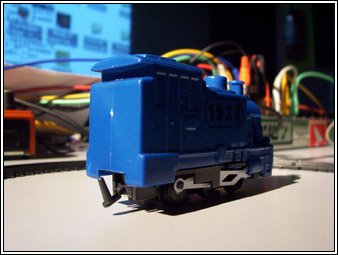The Aesthetics of Representation in Circuit Bending, by Eduardo Navas

Detail of Szkieve’s circuit bending performance at Montevideo, Uruguay, July 28, 2006.
Image source: http://www.hushush.com
Note: This text was specifically written as a contribution to ReFunct 09‘s Symposium taking place at ISEA 09.
One might wonder what is the concrete definition of “circuit bending.” In a way, the name does not completely connect with the actual activity of appropriating sound from pre-existing sources, ranging from electronic toys to hacked radios, or even half-broken generators. When I first heard the term, I thought it referred to strict manipulation of electronic signals. This possible definition hints at a certain purity in sound with specific electronic technology; yet, in 2009 circuit bending is quite the opposite, even if in the beginning it may have had a leaning towards hacking electronic gadgets of all types. At the moment, it is a hybrid practice that appropriates any type of sound, freshly recorded or pre-recorded; re-recorded or significantly manipulated; even erased or retraced–or captured live from the environment in which a performance is taking place to be bent immediately, on the fly.
My most memorable performance of circuit bending took place in Uruguay, on July 28, 2006. I attended a soundtoys event organized by Brian Mackern, one of the first net-artists from the southern cone, active since at least the mid-nineties. Mackern more recently has become a major supporter of sound performances of all types. The performance took place at the French Alliance of Montevideo, where I saw Mackern and a number of other sound artists perform on customized software interfaces. A couple of performers used Max MSP and Jitter, while Mackern presented a series of visual platforms built in Flash that remixed well-known movie clips from Hitchcock and Tarkovsky.
I saw a connection with the aesthetic of sound manipulation often found in circuit bending in these performances; yet, it was the performance of Szkieve (Dimitri della Faille), a Belgian-Canadian Sociologist that left a lingering impression on me. He is obsessed with collecting toys that produce noise in any shape or form with the purpose to use them in circuit bending performances. In fact, that afternoon, before the performance, I was invited by both Mackern and Szkieve to join them on a walk in downtown Montevideo. At the time I knew that Szkieve performed with toys, but did not know exactly how he developed his sets.
That evening Szkieve used a green plastic fish toy which he had bought from a street vendor during our walk. He pulled and released a string from the fish, which then emitted an expected fish-like sound that Szkieve slowly distorted into an echoish abstract noise, somewhat reminiscent of dub. Szkieve then combined the loop with the distorted sample of a toy train that moved on a circular track. The pitch of the train’s motion was drastically lowered several notes, turning it into a cacophonous massive bass sound that directly contradicted the petiteness of the actual train. Szkieve also mixed loops from various electronic devices through a mixer. If the audience had not experienced the visual development of the performance, the sound could easily have been mistaken for just another experimental electronic mix, carefully developed in a music studio–rather than from toys found at any corner store.
Szkieve’s performance is a good example of how the key to creativity is not so much the ability to produce sound from scratch, or have an advanced skill in performance, but actually to be able to conceptualize the potential of material that may already have a function, or holds particular cultural value. In this sense, circuit bending is a unique link between individuals who believe that all production should be developed and manipulated from scratch, and individuals who are primarily invested in acts of sampling and recombining material, as commonly understood in Remix. Circuit bending exposes how in the end it is not important if something is performed live or looped, or is a mix of the two, but rather whether or not what is performed challenges the audience’s perception of the source material. This is true not just for sound and noise performers, but artists in all fields.
I must admit that I often view circuit bending primarily as a performance based medium. My case in point is Szkieve’s performance, in which the sound may not be as interesting on its own but in conjunction with its visual development.
However, Circuit bending is becoming more diverse. In 2009 it is closely linked to physical computing and all types of art installations. What is promising about circuit bending is that it can be a medium, as well as a tool: it can include software and hardware, or exclude either one, as long as its only requisite is met: that perception be bent. Most importantly, like Remix, circuit bending can also be an aesthetic, to be cited in literary terms:
The snare of a wet red elastic nylon wire licking the bass-line of grey wooden-nails bound with the blind screams of a last name never to be famous and always worth mentioning; the beat of gracefully scratched hair longer than the history of the will, pushing the finger that struggles to penetrate its own castration; the speed of trust on the Internet, showing off its color as it begins to understand its dependence on truth…
The series of workshops and symposium at ReFunct 09, taking place at ISEA, in Ireland, are likely to push circuit bending’s definition, perhaps to the point that people like myself will no longer desire a live performance, but simply aspire to think beyond representation as we know it.








